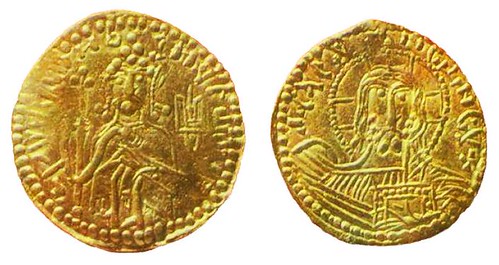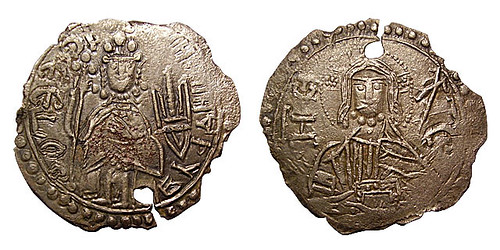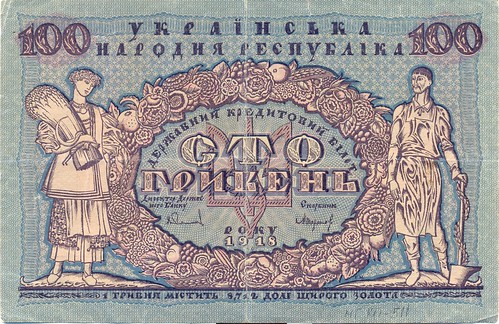
PREV ARTICLE
NEXT ARTICLE
FULL ISSUE
PREV FULL ISSUE
HISTORY OF UKRAINIAN CURRENCYDavid Pickup passed along this page on the history of Ukrainian currency from the National Bank of Ukraine. Here's an excerpt - see the complete article online if the site stays up. -Editor The history of the Ukrainian national currency
The hryvnia is Ukraine's official national currency. The name is derived from the word Coin production in the 10th to 12th centuries The first Ukrainian money, zlatnyks (gold coins) and sriblianyks (silver coins) were produced under Kyiv Prince Volodymyr the Great. These coins are the oldest extant documents that have an image of the trident, a symbol used by Kyiv princes.
The obverse of zlatnyks features the prince on a throne, a trident and the legend While the earliest coins produced by Western European countries copied Roman coins, including the portraits and legends placed on these coins, zlatnyks and sriblianyks only featured legends in the Old East Slavic language and bore images of Old Rus princes. Svyatopolk I of Kyiv (Svyatopolk the Accursed), Yaroslav the Wise and Oleg I of Chernihiv (Prince of Tmutarakan) also produced silver coins. The Ukrainian Revolution of 1917 to 1921 During Ukraine's struggle for independence from 1917 to 1921, the introduction of a national currency and the establishment of an independent banking system were of great importance in creating a sovereign Ukrainian state. On 22 December 1917, the Central Council adopted a law declaring the Russian State Bank's Kyiv branch Ukraine's state bank. Mykhailo Kryvetskyi was appointed the first director of the bank. It was Kryvetskyi who signed the first banknote issued by the independent Ukrainian state – the 100 karbovanets banknote, which was put into circulation on 5 January 1918. One karbovanets was equivalent to 17.424 measures of pure gold, with one measure equaling 0.044 g of gold. While designing the 100 karbovanets banknote, artist Heorhiy Narbut incorporated the trident into its design as the symbol that was found on the oldest Ukrainian coins – the zlatnyks and sriblianyks made by Volodymyr the Great. On 1 March 1918, the Central Council passed a law that introduced a new unit of money, the hryvnia, which consisted of 100 shahs and equaled 1/2 of a karbovanets.
To read the complete article, see:
Wayne Homren, Editor The Numismatic Bibliomania Society is a non-profit organization promoting numismatic literature. See our web site at coinbooks.org. To submit items for publication in The E-Sylum, write to the Editor at this address: whomren@gmail.com To subscribe go to: https://my.binhost.com/lists/listinfo/esylum All Rights Reserved. NBS Home Page Contact the NBS webmaster 
|


